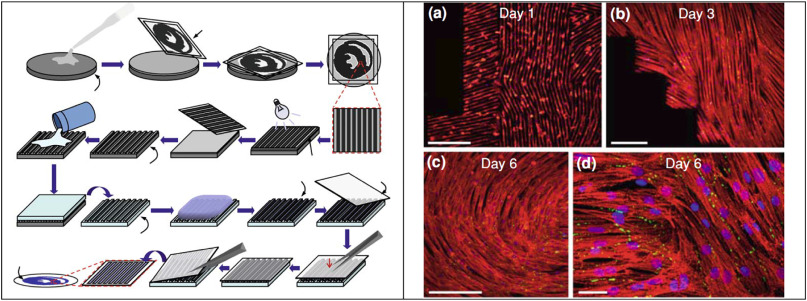An organ on a chip is a tiny cell culture that mimics the structure and function of human tissue – a micro-organ, if you will, that allows scientists and medical professionals to test pharmaceuticals and other treatments. In a paper entitled “Heart on a chip: Micro-nanofabrication and microfluidics steering the future of cardiac tissue engineering,” a group of researchers discusses the use of 3D bioprinting and other techniques to create a heart on a chip.
The researchers present a thorough look at the many ways in which cardiac tissue engineering has been approached.
“Optical lithography, soft lithography and plasmas have provided tools for structural and chemical modification in planar two dimensional fashion,” they state. “Lasers, electrospinning and 3D bioprinting have provided the capability to advance the fabrication even further, by providing the tools to fabricate structures into three dimensions. In several cases the combination of these techniques is employed, where additional functionalities or capabilities are needed from the construct. These approaches focused on culturing cardiac cells in a biomimetic environment in order to create a functional cardiac tissue.”
In these approaches, the main objective was to recapitulate the ECM that support cardiac cells; thus, the substrates or scaffolds are made from polymer materials. Depending on the method, cardiac cells were seeded on top of micro-nanoengineered materials in 2D or 3D structures or encapsulated within the polymeric matrix.
“The 2D structures have provided with useful information on the effect of geometries on cardiac cells structural properties,” the researchers state. “The 3D scaffolds have been applied, although in a limited number, for cardiac cell therapy by means of implantation in animal models carrying a specific cardiac disease. The idea of this therapeutic direction is on restoring some functionality in heart scarred regions by providing a new pool of functional cardiac cells. This application falls under the category of cardiac regenerative medicine with final target the clinical trials by implanting the cellularized scaffolds to patients.”
3D printing makes sense as a way to create a heart on a chip, as cardiac cells can be taken from patients and deposited in a layer-by-layer approach that allows them to grow into a micro-organ. This allows scientists to study the cardiac pathophysiology and test drugs in vitro, and can also lead to individual patient-targeted therapy. These hearts on chips can also provide useful information about treatments that should not be used to treat cancer, for instance, because they are found to cause cardiac cell toxicity in the miniature culture. These discoveries offer more value than testing on animals, whose physiology does not always respond in the same way to drugs as does that of humans.
Microfluidics are also a big part of the creation of hearts on chips. The researchers point out that the technology is starting to be used to mimic specific diseases such as pathological cardiac hypertrophy and ischaemia.
“Actually, some of the described micro/nanofabrication technologies have been incorporated to the microfluidic systems, such as microcontact printed molded structures, as well as bio-printed 3D scaffolds, even though these cases pose the minority,” the researchers explain. “We envisage that the prior knowledge and the correct translation of the information extracted from the use of micro/nanoengineering in cardiac tissue engineering can lead to the development of multi-diverse ‘Heart on Chip’ systems tackling a wide spectrum of cardiac diseases.”
Authors of the paper include Maria Kitsara, Dimitrios Kontziampasis, Onnik Agbulut and Yong Chen.
Discuss this and other 3D printing topics at 3DPrintBoard.com or share your thoughts below.
Subscribe to Our Email Newsletter
Stay up-to-date on all the latest news from the 3D printing industry and receive information and offers from third party vendors.
Print Services
Upload your 3D Models and get them printed quickly and efficiently.
You May Also Like
U.S. Navy Lab Uses 3D Printing to Reduce Tooling Lead Time By Over 90%
The F-35 Lightning II Joint Program Office (JPO), responsible for life-cycle management of the key fifth-generation joint strike fighter (JSF) system used by the U.S., its allies, and its partners,...
Etsy Design Rule Change Reduces Selection of 3D Printed Goods
Online marketplace Etsy has implemented a rule change requiring all 3D printed goods on the site to be original designs. The update to the site’s Creativity Standards states, ¨Items produced using...
Honeywell Qualifies 6K Additive’s Nickel 718 for 3D Printed Aerospace & Defense Parts
6K Additive is renowned for manufacturing sustainable additive manufacturing (AM) powder, and offers a wide portfolio of premium metal and alloy powders that include titanium, copper, stainless steel, and nickel,...
MetalWorm Sells WAAM Systems to Research Institutes in Brazil and Malaysia
Turkish WAAM firm MetalWorm has sold a system in Malaysia and another in Brazil. This is an excellent example of a few emerging trends in additive. Firstly, WAAM was experimented...




































